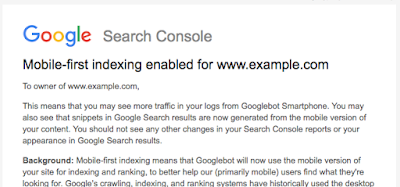
Today we’re announcing that after a year and a half of careful experimentation and testing, we’ve started migrating sites that follow the best practices for mobile-first indexing. To recap, our crawling, indexing, and ranking systems have typically used the desktop version of a page’s content, which may cause issues for mobile searchers when that version is vastly different from the mobile version. Mobile-first indexing means that we’ll use the mobile version of the page for indexing and ranking, to better help our – primarily mobile – users find what they’re looking for. We continue to have one single index that we use for serving search results. We do not have a “mobile-first index” that’s separate from our main index. Historically, the desktop version was indexed, but increasingly, we will be using the mobile versions of content. We are notifying sites that are migrating to mobile-first indexing via Search Console. Site owners will see significantly increased crawl rate from the Smartphone Googlebot. Additionally, Google will show the mobile version of pages in Search results and Google cached pages. To understand more about how we determine the mobile content from a site, see our developer documentation. It covers how sites using responsive web design or dynamic serving are generally set for mobile-first indexing. For sites that have AMP and non-AMP pages, Google will prefer to index the mobile version of the non-AMP page. Sites that are not in this initial wave don’t need to panic. Mobile-first indexing is about how we gather content, not about how content is ranked. Content gathered by mobile-first indexing has no ranking advantage over mobile content that’s not yet gathered this way or desktop content. Moreover, if you only have desktop content, you will continue to be represented in our index. Having said that, we continue to encourage webmasters to make their content mobile-friendly. We do evaluate all content in our index — whether it is desktop or mobile — to determine how mobile-friendly it is. Since 2015, this measure can help mobile-friendly content perform better for those who are searching on mobile. Related, we recently announced that beginning in July 2018, content that is slow-loading may perform less well for both desktop and mobile searchers. To recap: Mobile-indexing is rolling out more broadly. Being indexed this way has no ranking advantage and operates independently from our mobile-friendly assessment.Having mobile-friendly content is still helpful for those looking at ways to perform better in mobile search results.Having fast-loading content is still helpful for those looking at ways to perform better for mobile and desktop users.As always, ranking uses many factors. We may show content to users that’s not mobile-friendly or that is slow loading if our many other signals determine it is the most relevant content to show. We’ll continue to monitor and evaluate this change carefully. If you have any questions, please drop by our Webmaster forums or our public events. Posted by Fan Zhang, Software Engineer
Source: Google Webmaster Central Blog
Link: Rolling out mobile-first indexing



Leave a Reply